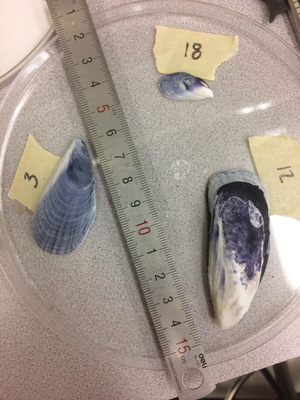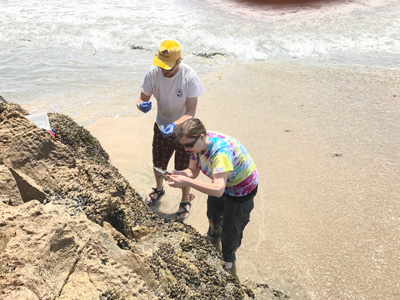Ocean Acidification is Transforming California Mussel Shells
New analyses reveal how over 60 years a critical marine species has responded to ocean acidification
January 12, 2021
By Mario Aguilera

California mussels collected during the new study were sampled, measured and eventually ground to a fine dust in order to reveal how the mineral composition of their shells have changed over 60 years.
The large mollusk known as the California mussel makes its home in the rocky shoreline along the Pacific Coast from Mexico to Alaska. Considered a “foundational” animal, Mytilus californianus provides homes for hundreds of other species and offers a rich food source for species ranging from spiny lobsters to humans.
As the waters off our coasts change due to human influences, scientists at the University of California San Diego are finding that the composition of California mussel shells is weakening as it becomes more tolerant of acidic conditions.
Scientists have known that rising levels of human-produced carbon dioxide that are increasingly absorbed into the world’s oceans will have an impact on sea life. But as ocean waters increasingly acidify, tracking impacts on specific species has been difficult to gauge over time. Most of what we know about species’ responses to acidifying waters comes from short-term experiments that suggest these increases in ocean acidity—causing a lowering of seawater pH and less availability of carbonate ions to make shells—can lead to less fortified shells and more vulnerable animals.
But not every species from these studies responds the same way, with some even appearing to do better under these conditions. This makes long-term studies looking at how increases in temperature and ocean acidification impact species extremely valuable for understanding and ultimately making predictions about future vulnerability of these species.
Comparing new data with samples collected in the 1950s, UC San Diego Division of Biological Sciences graduate student Elizabeth Bullard and Professor Kaustuv Roy found that ocean acidification is transforming the composition of California mussel shells from mostly the mineral aragonite to the mineral calcite. Aragonite is much stronger than calcite and makes for a better shell to protect against predators and wave energy, two things that are expected to increase with warming waters. Calcite, on the other hand, is much weaker but does not dissolve as easily as aragonite—making a better shell material if the waters are acidifying. Experts had expected aragonite, the stronger of the two substances, to emerge as the dominant mussel shell mineral due to its preference to form in warmer waters. Instead, the new study has shown that the weaker but more stable calcite mineral is now the dominant shell substance, a response linked to increases in ocean water acidity. The results are published in the Proceedings of the National Academy of Sciences.
“We found that these mussels are indeed secreting more calcite today than they were 60 years ago,” said Bullard. “Lower pH eats away the shells these animals are able to create, so it’s considered a major problem for marine organisms. There are 303 species that are associated with the California mussel, so if we lose the mussel we lose other species, some of which are really important to things like our fisheries and recreation.”

UC San Diego researchers have found that the shells of California mussels, a critical species found along the Pacific Coast, are weakening as a result of ocean acidification.
In the late 1950s, Caltech scientist James Dodd traveled the Pacific Coast from La Jolla to Washington state, collecting mussels along the way. His specimen sampling led to a valuable baseline of information about mussels and their shell composition, including the ratio of aragonite to calcite. One of the results of his work was a stark geographical contrast between cold northern waters, where mussels mostly featured calcitic shells, with the warmer southern waters where aragonite was the dominant shell mineral.
To find out how the shell mineral profile has changed across six decades, Bullard similarly traveled the coastline with her lab mate, graduate student Alex Neu, in 2017 and 2018 to collect new specimens in a survey that geographically replicated Dodd’s sampling. With more than 100 shell samples collected, Bullard then spent days meticulously grinding each shell down to a fine dust to dissect their composition—up to 16 hours of grinding for one shell in some cases.
“If you put too much heat or pressure on aragonite it will convert to calcite,” said Bullard. “Calcite is extremely stable but aragonite isn’t. In order to really make sure the ratio is accurate you have to be super careful and hand grind the specimens down to a super fine powder.”
Finally, project collaborator Professor Olivia Graeve and her materials science group in the UC San Diego Jacobs School of Engineering conducted X-ray diffraction analysis on each sample to determine their mineral profiles.
“By combining our expertise in crystallography of materials with our collaborator’s expertise in ecology, we were able to make a real impact on our understanding of humans’ long-term effects on other species,” said Graeve. “This type of interdisciplinary research is what’s required to continue advancing science and engineering for the benefit of our world.”
The results told a new story. Instead of a geographical boundary between north and south California mussel shells, the new survey revealed that acidic waters are reducing shell aragonite throughout the coast, leading to calcite as the dominant shell mineral.

UC San Diego Biological Sciences graduate students Elizabeth Bullard and Alex Neu traveled the Pacific Coast from La Jolla to Washington state collecting mussels that would form a comparison to mussels collected in the 1950s.
“James Dodd’s data fit in a world where the balance of temperature and ocean pH was very different from that today,” said Roy, a professor in the Section of Ecology, Behavior and Evolution (EBE). “For me it was surprising how big the effect was in 60 years. That’s not a huge amount of time as these things go, but the effect was striking.”
The researchers were surprised to find that ocean pH and changing amounts of carbonate availability, not temperature, played such a strong role in influencing shell mineralogy. It’s a finding that would not be possible without Dodd’s critical baseline work.
“This study highlights the importance of utilizing long-term data sets and large spatial comparisons to understand and test predictions about species responses to a changing world,” the authors write in the paper.
Bullard and Roy are now probing deeper into shell viability questions. They are conducting lab experiments to test how this change from aragonite to calcite might impact the strength and overall function of the mussel shell.
Co-authors of the paper include: Elizabeth Bullard, Ivan Torres, Tianqi Ren, Olivia Graeve and Kaustuv Roy.
A grant from NASA and the Jeanne Marie Messier Memorial Endowment Fund (EBE) supported this research.
